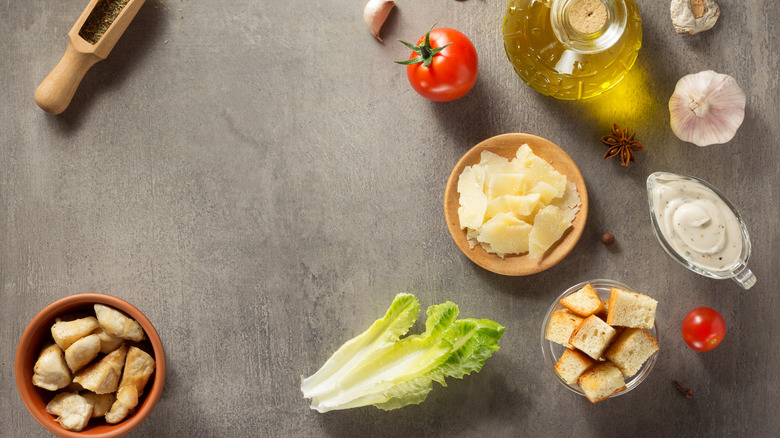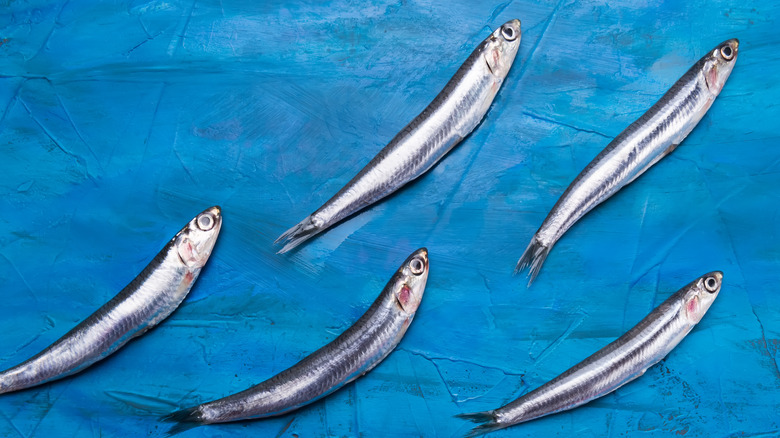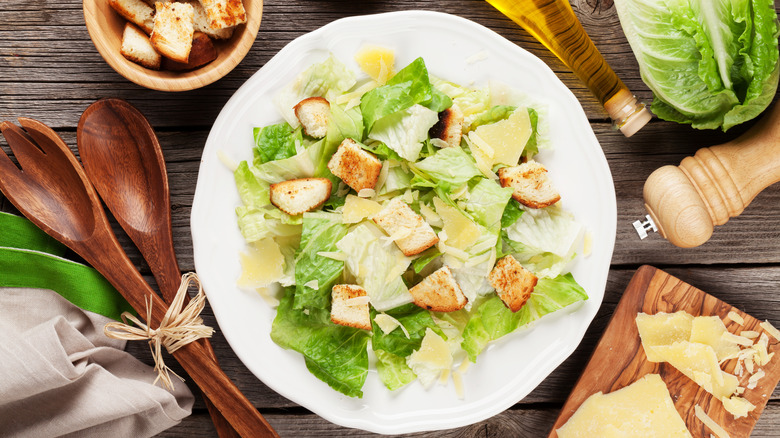The Surprising Ingredient You Can Find In The Caesar Salad You're Eating
Few dressings make it onto American menus as often as Caesar. The salad is creamy, crisp, refreshing, and it owes much of its success to its salty, savory, parmesan-tinged dressing. The crunchy culinary success was derived in Tijuana, where an Italian-American chef allegedly improvised the salad during a busy Fourth of July.
Of course, the recipe has seen countless variations since it was born in the 1920s. We've seen it all: Caesar salads tossed with kale or shredded Brussels sprouts, rather than romaine, yogurt-based Caesar dressing, tuna-studded Caesar salad lettuce cups, wraps, sandwiches, pasta salad... Frankly, we're not sure how the salad's inventor, Caesar Cardini, would feel about any of this (via My Recipes).
But the more traditional take on Caesar salad includes some ultra-savory ingredients that you might find rather unsavory: Worcestershire sauce, and, in some variations, anchovies. The former has been included in the salad since the day it was created in Mexico. The latter was added later on, and some cooks swear by it. There's also the whole raw egg debate.
A fishy list of ingredients
Worcestershire sauce is a mysterious ingredient. The sauce is actually fermented, and it's not even vegetarian. Who knew? It can be difficult to pin down the acidic, sharp flavor of Worcestershire, but it's commonly made from vinegar, tamarind, soy sauce, and anchovies.
A more contentious ingredient in the Caesar salad is the salty, visually-unappealing anchovy. Often, the oily little fish are chopped or pulverized into the Caesar dressing, to add some additional umami flavor to the rich olive oil and creamy eggs, according to Bon Appétit. Still, in this country of picky eaters, people can get squeamish. "So many people say 'yuck' when they hear the anchovy is in there, but you need it for that little zing," corporate chef Anthony Tammero told The New York Times.
Here's the weird, anchovy-stuffed plot twist: It turns out Caesar Cardini didn't even use anchovies in his recipe. In fact, he was staunchly against the use of anchovies. Cardini believed that the anchovies were too strong an addition. The Worcestershire sauce, he argued, supplied enough fishy, savory flavor. Sure enough, Caesar salad-fan Julia Child visited the Tijuana restaurant, and developed a well-used recipe without anchovies (via Epicurious).
To egg or not to egg
With our increased awareness of salmonella poisoning, raw egg in a salad can be a bit of a sore spot for some eaters. However, it's important to note that on that fateful day the salad blessed the world, Cardini likely didn't break a bunch of raw eggs into the salad. His recipe involves coddled eggs, according to The New York Times. Julia Child's recipe emulates this practice, calling for salad makers to place the egg into simmering water for just one minute. This certainly doesn't leave you with a hard-boiled (or even soft-boiled) egg, and it doesn't eliminate the risk of salmonella, but some chefs claim it helps play into the dressing's creamy texture.
Of course, using pasteurized eggs will allow you to delve into the original Caesar salad recipe safely, and without a fear of salmonella bacteria. Then, you're free to experiment with anchovies, Worcestershire, and eggs to your salad-loving heart's content (via Chicago Tribune).


